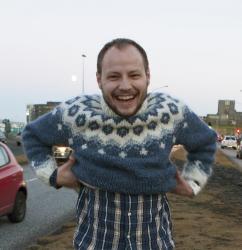Welcome to The Edda or Whatever, where I’m spilling the tea on Norse mythology. We’re breaking down the Prose Edda, a Medieval Icelandic textbook that also low-key recaps most of what we know about the Norse gods today, but we’re doing it with a little bit of style and a whole lot of sass. (Not to mention ass!) If you’ve ever wondered, “Wasn’t Þórr like the blockhead of the Norse gods?” (he was) or, “Didn’t Loki get dicked down by a literal horse?” (he did)… Then shut up, I’m getting to it.
Bumps on an epilogue
Now that the author Snorri has explained how poetry was invented and we’ve been properly grossed out by how many different bodily fluids were involved in the process, he jumps into what he calls an epilogue. For all he knows about poetry, he doesn’t seem to know much about basic narrative structure because last I checked, an epilogue doesn’t generally appear about 10% into the second-to-last section of any text. But what do I know? I’m just a hack who puts his epilogue where the sun don’t shine. (Iceland lol.)
Snorri’s epilogue is not that different from his prologue. If you’ve been keeping up with this series, you’ll know what I mean when I say Snorri’s back on his bullshit. He offers a stern reminder that the events he’s depicted of the Norse gods are actually just allegories of the Trojan War, for educational purposes only, aNd GoOd CrIsTiAnS dOn’T bElIeVe In ThEm. He rambles on about how Ásgarður is Troy, Þórr is Hector, Jörmungandur is Achilles, and Ragnarök is the fall of Troy. Like, “Sure, Grandpa, we get it: Troy ahoy! Let’s get you to bed.”

Need 4 speed
Once he gets off his Trojan horse-shaped soapbox, he finally (finally [FINALLY]) dives into the nitty-gritty of Old Norse poetry: kennings. Kennings are hilariously specific references referring to common things, so that every poem basically becomes a crossword puzzle. If it says “whale road,” it means “sea;” if it says “Óðinn’s son,” it means “Þórr;” and if it says “the king of Norway’s lil’ bootlickity bitch,” it means “Snorri Sturluson.” Stuff like that. The rest of Skáldskaparmál is basically an encyclopaedia of kennings, occasionally stopping to explain some of their dubious origins.
In one of these, a giant named Hrungnir claims his horse is better than Óðinn’s. To prove him wrong, the butthurt Óðinn races him to Ásgarður, and although he wins, the giant slips in through the gates. Just like every dude at every bar ever, he promptly gets drunk and harasses the local goddesses, refusing to leave. To get him out, Þórr challenges him to a fight: “Meet me at the flagpole outside Giant High School at 3pm, or else!” The terrified giants build a golem out of mud and bring it to life with a horse heart to defend them against Þórr, but it literally pisses itself when it sees him. Þórr’s slave kills it nbd.
Þórr kills Hrungnir, but not before the giant manages to shove a rock into Þórr’s head. Þórr gets trapped under the giant’s body. When Þórr’s son Magni frees him, Þórr gifts him Hrungnir’s horse, sending Óðinn into a jealous rage like a little girl who didn’t get a pony for her birthday. As a witch named Gróa tries to remove the rock from Þórr’s head, he tells her that he turned one of her husband’s toes into a star and she’s so happy she forgets all her magic. The stone stays stuck in Þórr’s head forever, thus explaining why he’s such a dumbfuck.
Sticks and stones
Another little ditty about our favourite dimwit starts, as usual, with our favourite troublemaker, Loki. He’s just casually tormenting some giants when he manages to get his ass kidnapped by a giant named Geirröður, who locks Loki in a box and starves him for three months. In order to buy his freedom, he agrees to lure Þórr the dumbfuck to Geirröður without his famous drip: his magic belt, his magic gloves, and, of course, his magic hammer. Þórr may be a macho mess, but only a true queen knows how to accessorise like that.
Luckily, Þórr crashes with Gríður, a kind giantess who understands his fashion dilemma. She lends him her own belt and gloves, along with some kind of staff. I guess those were trendy back then. On his way to Geirröður’s castle, one of the giant’s daughters tries to drown him in a river. By the power of the belt, he throws a boulder at her and escapes. Then he arrives and sits down, but little does he know that Geirröður’s giant daughters are hidden under his seat (best not to question the physics of that). They rise up and try to crush him against the ceiling, but Þórr saves himself with his new second-favourite pole, using it to push himself down. This breaks the giantesses’ backs and kills them.
After Þórr has sat on Geirröður’s daughters and crushed them to death — and like, not even in a sexy way — their father naturally invites Þórr to play a game with him. The game is like catch, but with a ball of molten iron. He whips it at Þórr using tongs, but Þórr catches it thanks to his borrowed gloves. He throws it right back, burning a lava-ball-shaped hole right through Geirröður. Considering how Þórr is a god of few words and even fewer brain cells, I think that’s the closest he’ll ever come to a hot take. How’s that for poetry?
Morals of the story:
– Some writing advice: if you don’t know where to stick your epilogue, maybe just keep it to yourself.
– When in doubt, accessorise, accessorise, accessorise!
Read more Edda or Whatever here, and buy Grayson’s book, The Sagas And Shit, here — and support the Grapevine directly in the process!
Buy subscriptions, t-shirts and more from our shop right here!
















